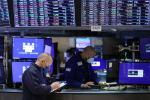
- All Instrument Types
- Indices
- Equities
- ETFs
- Funds
- Commodities
- Currencies
- Crypto
- Bonds
- Certificates
Please try another search

Stock Market News For May 13, 2016

Benchmarks closed mixed after shares of Apple declined to a two-year low, which in turn had a negative impact on the S&P 500 and Nasdaq. Moreover, sell-off in healthcare stocks had a negative impact on benchmarks. However, the Dow managed to end in the green despite Apple’s decline. Meanwhile, gains in telecom and consumer staples sector helped markets curb some of their losses.
For a look at the issues currently facing the markets, make sure to read today’s Ahead of Wall Street article
The Dow Jones Industrial Average (DJI) increased 0.1%, to close at 17,720.50. The S&P 500 fell 0.35 points to close at 2,064.11. The tech-laden Nasdaq Composite Index closed at 4,737.33, losing 0.5%. The fear-gauge CBOE Volatility Index (VIX) decreased 1.9% to settle at 14.41. A total of around 7.2 billion shares were traded on Thursday, in line with the last 20-session average. Decliners slightly outpaced advancing stocks on the NYSE. For 50% stocks that declined, 46% advanced.
Shares of Apple Inc. ( (NASDAQ:AAPL) ) declined 2.4% or $2.17 to $90.34, hitting its lowest closing level since June 2014, following concerns over a slump in iPhone sales. Reportedly, its Taiwanese suppliers expect a fall in iPhone orders in latter part of 2016 following weak demand. Slump in Apple’s shares also affected its market capitalization. Total market cap of Apple yesterday was $494.7 billion, lower than Alphabet Inc’s ( (NASDAQ:GOOGL) ) market cap of $494.9 billion, making Google the world’s biggest company.
Slump in Apple’s shares had a negative impact on technology stocks, which in turn dragged the tech-based index, Nasdaq to end into the red. The Technology Select Sector SPDR (XLK), which fell 0.3%, and was one of the biggest decliner among the S&P 500 sectors. Some of its major components including Micron Technology, Inc. ( (NASDAQ:MU) ), Broadcom (NASDAQ:BRCM) Limited ( (NASDAQ:AVGO) ), Intel Corporation ( (NASDAQ:INTC) ), MasterCard Incorporated ( (NYSE:MA) ) and Yahoo! Inc. ( (NASDAQ:YHOO) ) decreased 4.7%, 2%, 1%, 0.6% and 0.9%, respectively.
Additionally, sell-off in biotech stocks led the Health Care Select Sector SPDR (XLV) to decrease 0.6% and emerge as the worst performer among the S&P 500 sectors. The iShares Nasdaq Biotechnology (IBB) fell 1.7%. Key stocks from the bio-tech sector including Allergan (NYSE:AGN_pa) plc ( (NYSE:AGN) ), Biogen Inc. ( (NASDAQ:BIIB) ), Amgen Inc. ( (NASDAQ:AMGN) ), Gilead Sciences Inc. ( (NASDAQ:GILD) ) and Regeneron Pharmaceuticals, Inc. ( (NASDAQ:REGN) ) declined 3%, 1.7%, 0.8%, 1.4% and 1.7%, respectively.
However, gains in telecom and consumer staples stocks helped markets offset some of yesterday’s losses. The telecom services sector within the S&P 500 gained 0.7%. Some of its key holdings including Verizon Communications Inc. ( (NYSE:VZ) ), AT&T, Inc. ( (NYSE:T) ) and CenturyLink, Inc. ( (NYSE:T) ) rose 0.6%, 0.9% and 0.5%, respectively.
Further, the Consumer Staples Select Sector SPDR ETF (NYSE:XLP) rose 1.6%. Key consumer staples stocks including Procter & Gamble Company (NYSE:PG) (PG), Coca-Cola Company (NYSE:KO) (KO), CVS Health (NYSE:CVS) Corporation (CVS), Kraft Heinz Company (KHC) and Altria Group (NYSE:MO), Inc. (MO) increased 0.3%, 0.8%, 0.7%, 1.3% and 0.6%, respectively.
In economic news, the U.S Department of Labor reported that seasonally adjusted initial claims increased 20,000 to 294,000 in the week ending May 06, reaching its highest level since Feb 28, 2015. Also, initial claims were more than the consensus estimate of 266,000.
Moreover, Cleveland Fed President Loretta Mester said that stability in oil prices and stronger dollar have helped core inflation rate move higher. She added that recent data is “encouraging and consistent with the Fed policy committee’s view that inflation will gradually move back to target over time.”
Meanwhile, Kansas City Fed President Esther George had shown support for “a gradual adjustment of short-term interest rates toward a more normal level”. However, she viewed “the current level as too low for today’s economic conditions.”
Also, Boston Fed President Eric Rosengren said that U.S. economy is slowly recovering in this quarter and recent “data [is] consistent with gradual improvement.” Rosengren also said that he expects that “second-quarter gross domestic product will rebound above 1.75%” from first quarter’s sluggish 0.5% rate. He added that “the market is too pessimistic about the fundamental strength in the U.S. economy.”
In company news, Monsanto (NYSE:MON) Company’s (MON) shares jumped 8.4% following speculation that both BASF SE (DE:BASFN) (BASFY) and Bayer AG (DE:BAYGN) (BAYRY) have separately shown their interest to acquire the St. Louis-based company. Monsanto was the biggest advancer among the S&P 500 companies, while Kohl’s Corporation (KSS) was the biggest loser.
Shares of Kohl’s fell 9.2% after its fiscal first quarter earnings of 31 cents per share declined 50% year-over-year and missed the Zacks Consensus Estimate of 36 cents. Net sales of $3.972 billion also lagged the Zacks Consensus Estimate of $4.124 billion and declined 3.7% year-on-year. Moreover, profit in the last quarter fell 87% and sales witnessed a surprise drop for the first time in last six quarters.
APPLE INC (AAPL): Free Stock Analysis Report
ALPHABET INC-A (GOOGL): Free Stock Analysis Report
MICRON TECH (MU): Free Stock Analysis Report
BROADCOM LTD (AVGO): Free Stock Analysis Report
INTEL CORP (INTC): Free Stock Analysis Report
MASTERCARD INC (MA): Free Stock Analysis Report
YAHOO! INC (YHOO): Free Stock Analysis Report
ALLERGAN PLC (AGN): Free Stock Analysis Report
BIOGEN INC (BIIB): Free Stock Analysis Report
AMGEN INC (AMGN): Free Stock Analysis Report
GILEAD SCIENCES (GILD): Free Stock Analysis Report
REGENERON PHARM (REGN): Free Stock Analysis Report
VERIZON COMM (VZ): Free Stock Analysis Report
AT&T INC (T): Free Stock Analysis Report
CENTURYLINK INC (CTL): Free Stock Analysis Report
Original post
Related Articles

Defense stocks took a tumble heading into 2025 as President Trump returned to the White House for his second term. Trump has stated his intent as a peacemaker to bring the wars in...

Using the Elliott Wave Principle (EWP), we have been tracking the most likely path forward for the Nasdaq 100 (NDX). Although there are many ways to navigate the markets and to...

Investors are on edge about what tariff policy means for markets Coming off a strong Q4 earnings season, fresh February corporate sales figures can help assess the macro...
Are you sure you want to block %USER_NAME%?
By doing so, you and %USER_NAME% will not be able to see any of each other's Investing.com's posts.
%USER_NAME% was successfully added to your Block List
Since you’ve just unblocked this person, you must wait 48 hours before renewing the block.
I feel that this comment is:
Thank You!
Your report has been sent to our moderators for review





Add a Comment
We encourage you to use comments to engage with other users, share your perspective and ask questions of authors and each other. However, in order to maintain the high level of discourse we’ve all come to value and expect, please keep the following criteria in mind:
Enrich the conversation, don’t trash it.
Stay focused and on track. Only post material that’s relevant to the topic being discussed.
Be respectful. Even negative opinions can be framed positively and diplomatically. Avoid profanity, slander or personal attacks directed at an author or another user. Racism, sexism and other forms of discrimination will not be tolerated.
Perpetrators of spam or abuse will be deleted from the site and prohibited from future registration at Investing.com’s discretion.